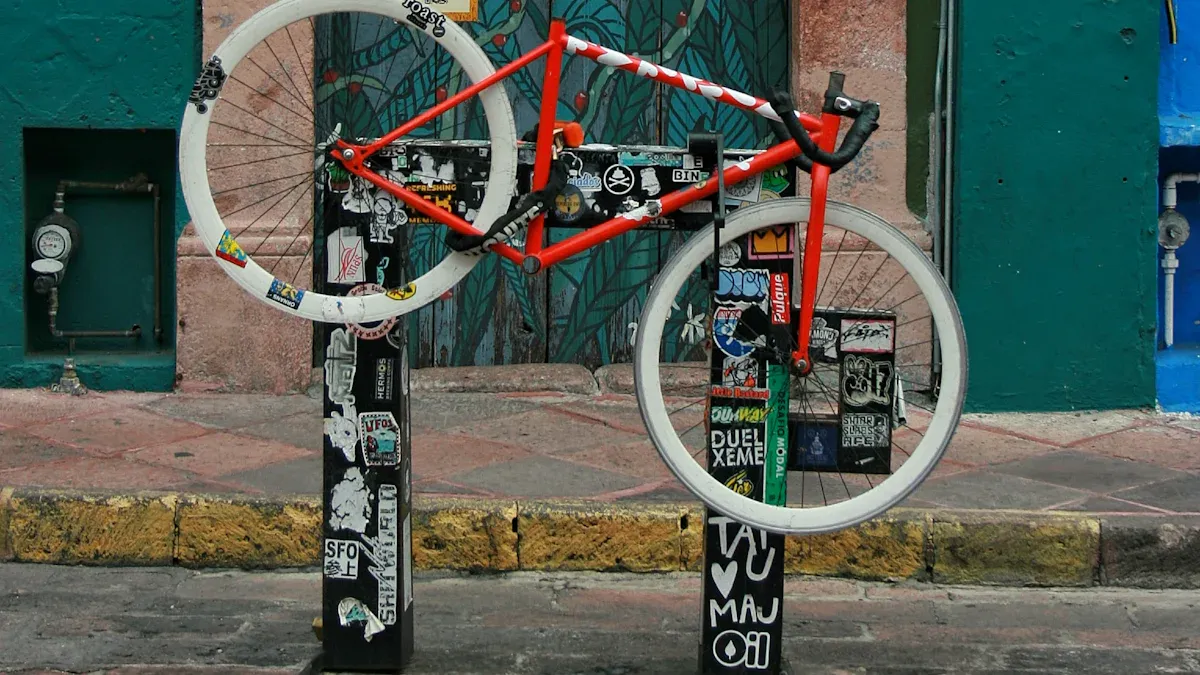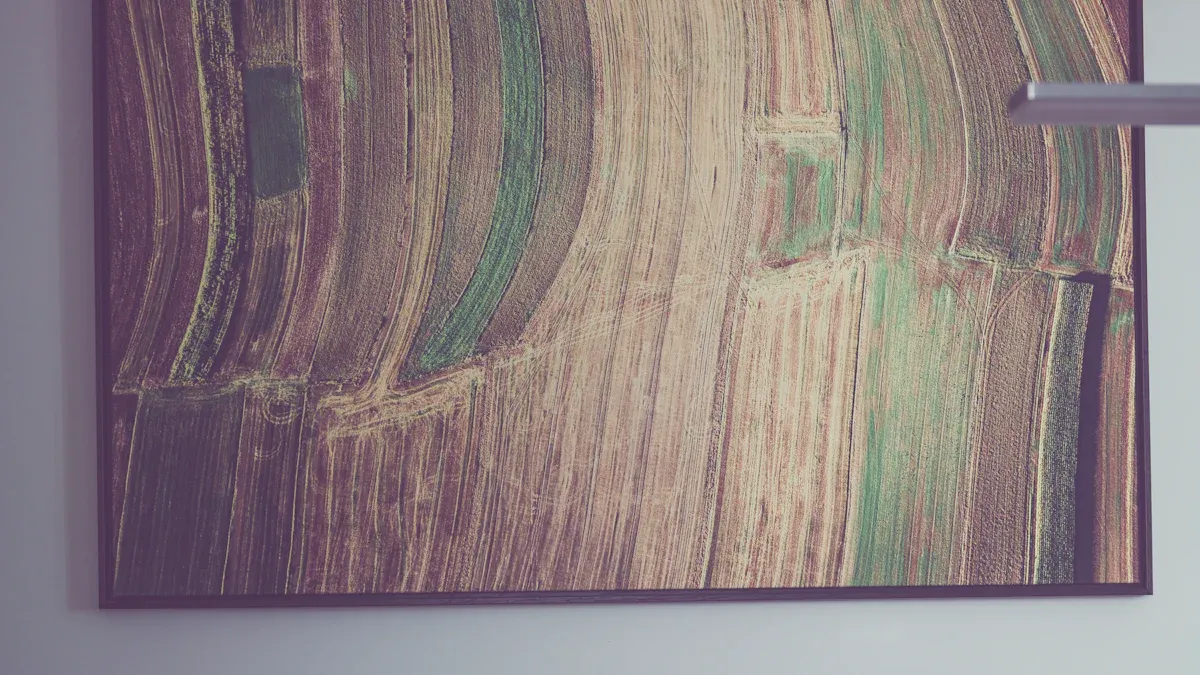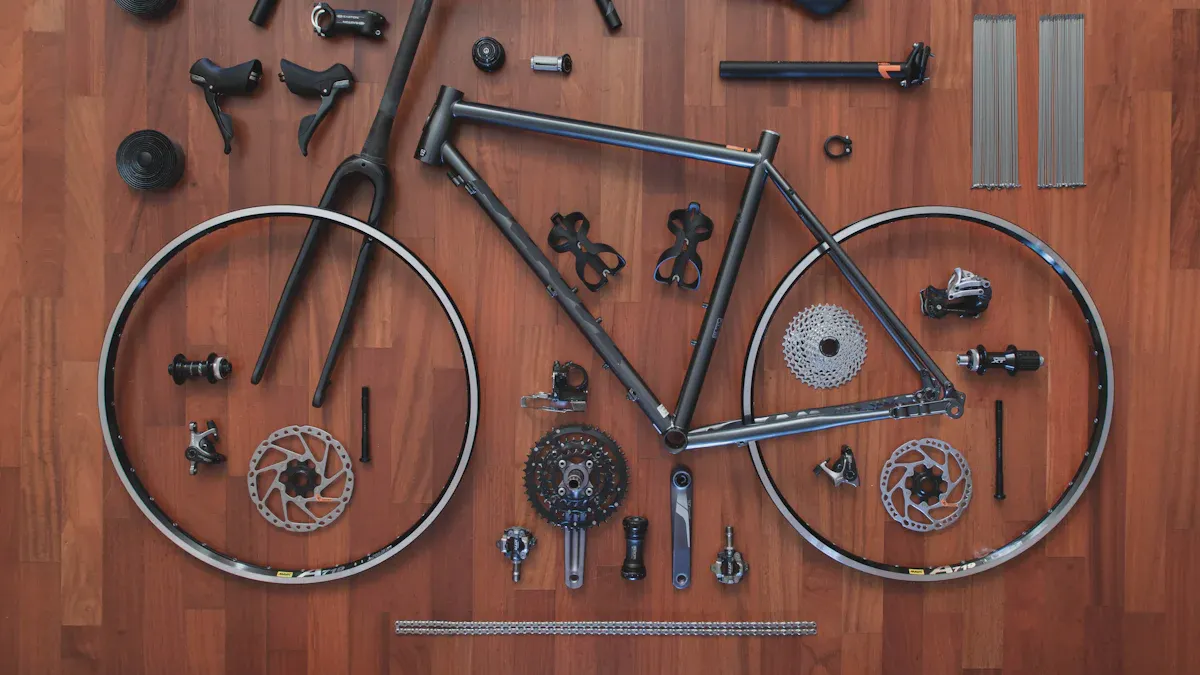
Brazing bike frames is very important in the process of building a bicycle. It helps you connect metal parts with a filler metal, creating strong and lasting connections. Two main methods are popular in brazing bike frames:
Lug Brazing: This method uses lugs to join the tubes, allowing the filler metal to flow into the lugs and create a strong bond.
Fillet Brazing: In this method, lugs are not used. Instead, the filler metal acts like glue at the joint, providing more design options.
Both methods enhance your bike’s performance and appearance, which is why brazing bike frames is a popular choice among frame builders.
Key Takeaways
Brazing bike frames joins metal parts with a filler metal. This makes strong and lasting connections.
Fillet brazing gives design choices and lighter frames. Lug brazing offers strength and a classic look.
Brazing uses lower temperatures than welding. This keeps the frame materials strong.
Customization is a big advantage of brazing. It lets cyclists make unique bikes that show their style and needs.
A good brazed joint can be strong enough for high-performance bikes. This makes it a popular choice for cyclists.
What is Brazing?
Brazing is an important method in making bike frames. It uses a filler metal to connect metal tubes without melting them. Here are some key points about brazing:
Brazing happens at lower temperatures than welding. The filler metal melts at over 840°F but below the melting point of the frame materials. This keeps the tubes strong.
It is very helpful for steel frames. The lower heat reduces brittleness and makes them stronger.
Two common types of brazing are:
Fillet Brazing: This method uses brass to make a strong joint.
Lug Brazing: This technique uses lugs to join the tubes, creating a strong bond.
When you compare brazing to welding, you will see some big differences.
Process | Temperature (°C) | Filler Material | Joint Strength |
|---|---|---|---|
Welding | ~1300 | Parent material melted | Mechanically stronger (with normalizing) |
Brazing | ~900 | Filler material used without melting parent material | Weaker than welded joints but no need for normalizing |
Welding uses the parent material as filler, which melts during the process. In contrast, brazing uses a different filler material that does not melt the parent material. This difference is important because welded joints are usually stronger due to melting the parent material and the normalizing process. However, a good brazed joint can be very strong. It spreads stress over a larger area, lowering the chance of failure near the joint.
Many people think welding is always stronger than brazing. While welded joints can be stronger, a well-made brazed joint can be strong enough for bike frames. The quality of the joint is more important than the method used.
Knowing these differences helps you understand the art of brazing bike frames. It mixes function with skill, making sure your bike is both strong and good-looking.
Methods of Brazing Bike Frames

Brazing bike frames uses two main methods: fillet brazing and lug brazing. Each method has its own features, benefits, and difficulties. Knowing these methods helps you pick the best one for your bike frame.
Fillet Brazing
Fillet brazing is a way where the filler metal makes a smooth joint where two tubes meet. This method gives you more design choices, making it good for odd shapes. Here are the main steps for fillet brazing a bike frame:
Mix flux paste (flux + water) and put it around the joints.
Heat the braze gently, then dip it in flux powder if needed.
Tack each joint first by adding a spot of braze on the top and bottom. Then do the same on the left and right.
Clean the tack brazes before putting more flux paste for the fillet brazing.
Optional: take the frame out of the jig. You might need to add heat sinks to the bottom bracket and seat tube.
Braze around each joint smoothly and quickly to prevent overheating and bending the frame.
For fillet brazing, you usually use materials like SIF Bronze No.1, flux, and an oxy-propane or oxy-acetylene torch. This method can take more time and needs skill. However, it allows for lighter frames and special designs.
Method | Advantages | Disadvantages |
|---|---|---|
Fillet Brazing | Good for odd shapes and layouts; can be lighter than lugged frames | Takes more time; needs more skill; longer heat cycles can cause overheating |
Lug Brazing
Lug brazing uses lugs, which are outside parts that connect the steel tubes. This method is important in bike making and has many benefits. The tubes are cut and shaped for a tight fit before going into the lugs. A filler metal, usually silver or brass, is melted to join the tubes to the lugs, making the joint stronger through capillary action.
Common types of lugs include:
Lug Type | Function |
|---|---|
Seat Lug | Connects the top tube and seat tube; may have sockets for seat stays and an opening for the seatpost. |
Bottom Bracket Shell | Connects the chain stays, seat tube, and downtube; has a threaded socket for the bottom bracket. |
Upper Head Lug | Connects the head tube and top tube. |
Lower Head Lug | Connects the head tube and down tube. |
Lug brazing is easier to control when making bikes and gives a nice finish. However, it can be heavier because of longer butted sections. This method is not as good for unique frame designs but works well for traditional bike building.
Both brazing methods for bike frames have their pros and cons. Fillet brazing offers flexibility and lighter frames, while lug brazing gives better control and a classic look. Knowing these differences helps you make smart choices about how to join your bike parts.
Advantages of Brazing Bike Frames
Brazing bike frames has many benefits. These advantages make it a popular choice for builders and cyclists. Knowing these benefits helps you understand why many frame builders like this method.
Strength and Versatility
One big advantage of brazing is its strength. Many users say that tubes bend before the joints break, whether the frame is brazed or welded. This means a good brazed joint can be strong enough for most cycling needs. Both brazing and welding can make strong frames if done right.
Brazing also allows for different designs. Here are some reasons why:
Brazed joints use lower heat than welding. This keeps the tubing strong.
They create a smaller heat-affected area, which lowers the risk of weakening the material.
You can use thinner tubing, which helps with design options without losing strength.
Steel is often chosen for brazing bike frames because it is strong and easy to fix. It is a good choice for long-lasting frames. Aluminum is also flexible in shaping and is cheaper, but it can be hard to repair and may wear out faster.
Aesthetic Appeal
The look of brazed bike frames is another big advantage. Many cyclists like the clean and smooth look of brazed joints. In fact, brazed joints usually need little to no finishing after joining, making them nice to look at right from the shop.
Here’s how brazed and welded joints compare in appearance:
Joint Type | Aesthetics Description |
|---|---|
Brazed | Clean, smooth, and nice-looking; often needs little to no finishing. |
Welded | Often has an uneven bead; usually needs grinding or finishing for a better look. |
When you compare fillet brazed frames to lug brazed frames, you can see clear visual differences:
Feature | Fillet Brazed | Lug Brazed |
|---|---|---|
Joint Appearance | Clear lugs at each joint, often with visible extra material | |
Tube Fit | Close fit with fish mouths cut into tubes | Tubes fit into lugs, making a more noticeable joint |
Overall Aesthetic | Sleeker, more streamlined look | More traditional, with a classic look because of lugs |
These visual qualities add to the overall charm of the frame. It becomes not just a useful piece of equipment but also a work of art.
Aesthetic Aspects of Brazing Bike Frames

Artistic Expression
Brazing bike frames is not only about being strong; it also lets builders show their art. Each bike maker designs their bikes to fit the rider’s needs and likes. This focus on detail makes sure the bike works well and looks great.
Fillet brazing really shows this art. The melted filler metal, usually bronze, connects two metal pieces. This process needs a lot of cleaning up, which lets skilled builders show off their work with careful finishing touches. For example, Erickson Cycles shows off unique brazing art. Glenn’s amazing skill makes strong joints between thin steel tubes, mixing classic lugwork with special fillet lugs. His work shows that brazing can be both strong and artistic.
Customization Options
Customization is a big part of brazing bike frames. Cyclists can pick different parts to make a bike that shows their style and fits their riding needs. Here are some customization choices you can make:
Customization Aspect | Details |
|---|---|
Materials | You can choose modern tubes from brands like Columbus, Dedacciai, Reynolds, or rare vintage tubes. |
Geometry | You can have fully custom geometry made just for you. |
Components | You can choose components, like carbon fiber forks from partners or custom steel forks. |
Aesthetic Choices | You can pick beautiful paint options and thinner lugs for a personal touch. |
You can also add features like brazed-on stainless head badges, S-bent stays, and curved seatstay bridges. Working with a frame builder makes sure every part of your bike, from gears to saddle, is made to improve performance and comfort. This level of personalization shows how important individual choices are in bike frame design.
By combining artistic expression and customization, brazing bike frames turns a useful object into a special piece of art that shows your personality and riding style.
In short, brazing bike frames uses two main methods: fillet brazing and lug brazing. Each method has its own benefits. Fillet brazing lets you create cool designs and lighter frames. Lug brazing gives strength and a classic look.
Getting bike frames ready for brazing is very important. Coating surfaces with flux helps make strong bonds. This makes the bike last longer and work better.
Both methods help improve the quality of bike frames. They make them stronger and allow for creative designs. Custom frames turn into unique pieces of art, making them more appealing to cyclists. By picking the right brazing method, you can have a bike that works well and looks great.
FAQ
What materials can I use for brazing bike frames?
You can use steel, brass, and bronze for brazing. Steel is strong and easy to fix. Brass and bronze work well as filler metals. They help make strong joints.
How does brazing compare to welding in terms of cost?
Brazing usually costs less than welding. The materials and tools for brazing are often cheaper. You also save on labor costs because brazing can be faster for some designs.
Is brazing strong enough for high-performance bikes?
Yes, brazing is strong enough for high-performance bikes. A good brazed joint can handle stress well. Many cyclists trust brazed frames for their strength and performance.
Can I customize my bike frame with brazing?
Absolutely! Brazing lets you customize a lot. You can pick different materials, shapes, and looks to make a bike that fits your style and needs.
How do I maintain a brazed bike frame?
To keep a brazed bike frame in good shape, check the joints for wear. Clean the frame with mild soap and water. Stay away from harsh chemicals that can harm the finish. Taking care of it helps it last longer and work better.
See Also
The Role of Science in Repairing Carbon Bike Frames
Key Tools and Supplies Needed for Custom Bike Frames
Learn Simple Techniques to Draw Bike Frames Like a Pro
